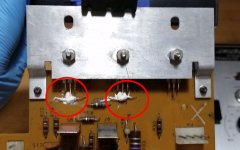I'm working on a small amp for an old film projector, and noticed blobs of thermal grease between the collectors of the output transistors and two diodes. Is this to facilitate some kind of thermal tracking between them? The transistors are MJE3055K.
Attachments
That stuff looks like white thermal paste which is normally put on active devices to conduct heat.
I cant think how its aiding the two diodes --thermal tracking diodes judge the difference in heat between both legs and adjust the bias but they don't need paste.
OTOH--- diodes are a type of semiconductor and heat does have an effect carrier concentration by increasing it --that's forward bias --
reverse bias (increase in current ) would occur with a temperature rise .
Looking at the picture its a bit old school and maybe more modern devices were not available at the time to help with stabilization.
But if somebody knows better ??
I cant think how its aiding the two diodes --thermal tracking diodes judge the difference in heat between both legs and adjust the bias but they don't need paste.
OTOH--- diodes are a type of semiconductor and heat does have an effect carrier concentration by increasing it --that's forward bias --
reverse bias (increase in current ) would occur with a temperature rise .
Looking at the picture its a bit old school and maybe more modern devices were not available at the time to help with stabilization.
But if somebody knows better ??
Odd, right? The factory thermal grease was very heavy and sloppy all around, but these two spots seem too purposeful.
The reasoning could be that the center pin of the output device is in direct connection with the collector that dissipates the power. So the temp of that center pin is a measure of the transistor temp. By conducting that heat through the goop to the diode body you get some measure of temp tracking.
Jan
Jan
Minimally diode bodies should actually be touching collector legs; then a grease blob would *slightly* improve thermal contact.
If separated by 2 or 3 mm or worse, same as nothing.
Thermal grease is only better than *air* , not much more, and in tenths of a millimeter thickness.
Personally I would remove those diodes from board and epoxy them to actual heat sink.
Degreasing them first, of course 😀
If separated by 2 or 3 mm or worse, same as nothing.
Thermal grease is only better than *air* , not much more, and in tenths of a millimeter thickness.
Personally I would remove those diodes from board and epoxy them to actual heat sink.
Degreasing them first, of course 😀
i'd leave it as it is if it's in working condition...it it survived a few decades maybe it's jst good enough.
- Home
- Amplifiers
- Solid State
- Thermal Tracking?
